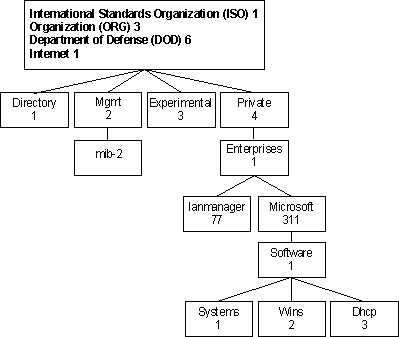
Each object in a MIB is identified by a universally unique label referred to as an object-identifier (OID). The object name space is implemented as a multi-part, hierarchical, naming scheme. A hierarchical naming scheme can be viewed as an inverted tree with the branches pointing downward. Each point where a new branch is added is referred to as a node. This OID is internationally accepted and allows developers and vendors to create new components and resources and assign a unique OID to each new component or resource.
The OID naming scheme is governed by the Internet Engineering Task Force (IETF). The IETF grants authority for parts of the name space to individual organizations, such as Microsoft. For example, Microsoft has the authority to assign the OIDs that can be derived by branching downward from the node in the MIB name tree that starts at 1.3.6.1.4.1.311.

Figure 11.2 A Managed-object Name Hierarchy
SNMP programs use the OID to identify the objects on each computer that can be managed by using SNMP. For example, when a network administrator requires information about managed-objects from some computer on the network, the SNMP management program sends a message over the network that requests information about the object as identified by the OID. The computer that receives the message can use the OID to retrieve information from the specific object on the computer and send the information back to the SNMP management program.